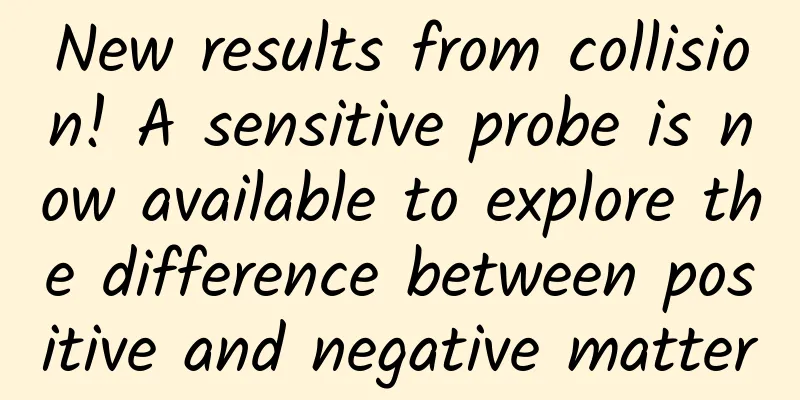New results from collision! A sensitive probe is now available to explore the difference between positive and negative matter

|
The Beijing Spectrometer III (BESIII) experiment at the Beijing Electron-Positron Collider has realized a new method, providing an extremely sensitive probe for studying the difference between matter and antimatter. The relevant research results were published in the journal Nature on June 2. All the anonymous reviewers of the paper praised this achievement highly: "Innovative measurement method", "very important", "very novel", "attractive", "very promising"... What kind of achievement made the anonymous reviewers so excited? Demonstration of positive-negative Corsi hyperon cascade decay. Photo provided by Institute of High Energy Physics, Chinese Academy of Sciences Antimatter that doesn't pair well "Matter-antimatter asymmetry" is a problem that has troubled the scientific community for more than half a century, and it is also a phenomenon that particle physicists have been looking for. They often mention a word - "CP violation". The "CP" in "CP destruction" is not the same as the "CP" (couple) in "CP formation" that we usually say. 13 billion years ago, the universe expanded and cooled rapidly after the Big Bang, and a large number of positive and negative particles combined and annihilated each other. However, just like a couple who have a quarrel, the positive and negative particles behaved differently during the combination and annihilation process. For every billion positive and negative particles that annihilated, one positive matter particle was left behind and eventually formed all the matter in the universe today. Scientists call the phenomenon that the decay processes of positive particles and antiparticles are different "CP violation." The name "CP violation" is closely related to Tsung-Dao Lee and Chen-Ning Yang. The "Parity Violation Law" they proposed and won the Nobel Prize in Physics holds that there is a "mirror" space reflection asymmetry in the weak interaction of particles. On this basis, scientists have concluded that "CP violation" exists. "CP violation can be used to explain why there is only matter but no antimatter in our world," Wang Yifang, director of the Institute of High Energy Physics of the Chinese Academy of Sciences and an academician of the Chinese Academy of Sciences, told China Science Daily. Why did the primordial antimatter in the universe disappear? Hyperion CP destruction may solve the mystery Since the 1960s, foreign scientists have successively discovered CP violation in meson systems. However, the asymmetry of matter and antimatter has not been perfectly explained. "Among the main particles that make up the world, there are very few mesons, and the extra positive matter produced when mesons decay is not enough to form the current world," said Wang Yifang. Unlike mesons, which are rare, baryons are the main particles that make up the world. "If we can find CP violation in baryons, we can better understand the mystery of the disappearance of primordial antimatter in the universe," said Wang Yifang. Unfortunately, scientists have never found CP violation in baryon decay because "weak decay signals are sometimes masked by strong interactions." "So if you want to see CP violation in baryons, you need sufficiently sensitive and innovative experimental methods to distinguish the signals of weak interactions from those of strong interactions," said Wang Yifang. A hyperon is a type of baryon, similar to a proton, but with a very short lifespan, so it cannot exist around us like a proton. Among the hyperons, there is a member called the "Corsi hyperon", which is composed of two strange quarks and a light quark. When the strange quark undergoes weak decay, it disappears. Hyperon decay is seen by scientists as "a promising hunting ground for searching for CP violation" because some of the information needed to measure CP violation can be directly measured through the decay of hyperons. High-precision measurement method discovered Since 2009, the BESIII experiment has collected about 10 billion J/psi particles from the "debris" of electron-positron collisions. These particles, called "J/psi", decay to produce positive-anti-Corcy hyperons, which then continue to decay and disappear. The researchers of the BESIII experimental group used 1.3 billion of the 10 billion particle events to analyze the birth process of positive and negative Corsi hyperons and reconstruct more than 70,000 positive and negative Corsi hyperon pairs. In this way, BESIII has become a clean and compact Corsi hyperon "factory". “Clean” because the background contamination rate is less than one thousandth. “Small” because the hyperon production in the BESIII experiment is not large. “Clever” because the sensitivity of the BESIII experiment is high enough. "Our hyperon yield is only one thousandth of the yield of an experiment called HyperCP at Fermilab in the United States, but the sensitivity of a single event is a thousand times that of a HyperCP event," said Li Haibo, spokesperson for the BES III experiment and researcher at the Institute of High Energy Physics of the Chinese Academy of Sciences. While analyzing the data, researchers from the BESIII experimental group discovered a method to measure hyperon CP violation with high precision. Earlier, they discovered that there is a special phenomenon between the newly decayed positive Corsi hyperons and anti-Corsi hyperons - "quantum entanglement". Therefore, using this unique quantum entanglement effect, combined with other data information of Corsi hyperons, the experimenters not only found the decay signals of positive Corsi hyperons and anti-Corsi hyperons from the massive data, but also measured the asymmetric parameters of positive-anti-Corsi hyperons with unprecedented accuracy. "The new method solves the 30-year dilemma of not being able to simultaneously and efficiently measure hyperons and their antiparticles, and also provides richer CP violation measurement results," said Li Haibo. "This achievement has attracted the attention of international peers. The relevant researchers were invited to give special reports at the 2021 International Lepton-Photon Conference, becoming rising stars in this field," said Wang Yifang. No new physical phenomena have been discovered yet, more data will be analyzed Unfortunately, the BESIII experimental group's measurement results did not show any signs of CP violation of hyperons. Even so, the discovery of the new method was still recognized by the international anonymous review. One anonymous reviewer commented: "Even though no new signs of CP violation have been found, the research method is still interesting." Another anonymous reviewer believes that "the new method points the way forward for future experiments and paves the way." "This innovative method brings hope for us to confirm or exclude sources of CP violation beyond the Standard Model in the future," said Wang Yifang. With this hope, the experimental team is challenging for higher measurement accuracy. "We hope to use this measurement method to find experimental evidence of hyperon CP violation in the near future." Wang Yifang said that the BESIII experimental team is analyzing 10 billion particle decay data, and the measurement accuracy is expected to be improved by about 3 times. Currently, this experimental team, which mainly conducts research in our country, faces fierce international competition. "The Large Hadron Collider bottom quark detector (LHC-b) at the European Organization for Nuclear Research is also producing a large number of hyperons. However, their background contamination rate is higher than ours." Li Haibo told China Science Daily that the BESIII experimental group's advantage in measurement lies in the "perfect detector design" of the BESIII experiment. BESIII is a detector on the Beijing Electron-Positron Collider, the earliest large-scale particle physics scientific facility in my country's history. It focuses on two scientific issues: how quarks form material particles and the origin of the asymmetry between matter and antimatter in the universe. Wang Yifang introduced that since 2009, the BESIII experiment has published more than 400 research results. The detector is planned to operate until 2030. As a large-scale high-energy experimental device independently developed by my country, the BESIII experiment has attracted about 500 researchers from 80 scientific research institutions in 17 countries and is currently the largest international cooperation group in China. The new results published this time were jointly completed by Chinese scientists and foreign collaborators. |
<<: Let's watch together! The "Chinese Dove Flower" from the Ice Age
Recommend
Is exercising at night more effective for losing weight? Experts say: Getting moving first is the most important thing!
Recently, a new exercise craze is emerging. After...
Analysis of WeChat Reading Products
This series of articles may reach nearly 50,000 w...
Fun fact: There are many stars in the universe, more than the grains of sand on Earth?
The universe is vast and boundless, and the numbe...
Ideas on introducing Lanchester equation into SLG games
[[147326]] The Lanchester equation has always bee...
Ten thousand words of dry goods summary: the most comprehensive interpretation of operational data indicators
Operations and data analysis are inseparable. Bus...
Madhouse "TIKTOK SHOP Small Store Practical Training Camp" Overseas small stores bring goods, master TK small store operations from 0 to 1
Course Content Catalog: TikTokShopi Training Camp ...
Should you take antibiotics immediately if you have pneumonia? Can't eat frozen steamed bread? Here comes the list of scientific rumors in November 2024 →
1. If you get pneumonia, do you need to take anti...
Why is criticism more memorable than praise?
© Frederic Cirou/Getty Images Leviathan Press: Re...
What is the customized development process of WeChat mini program in Guangzhou?
As WeChat’s functions improve, more and more peop...
“Heating food in a microwave oven can produce carcinogens”, is this true?
As a small household appliance that almost every ...
Justill 2021 AI Commercial Illustration Practical Training Camp Basics
: : : : : : : : : : : : : : :...
Android screen adaptation - just read this article
The reason why Android screen adaptation appears ...
China Automobile Dealers Association: The auto dealer inventory coefficient is 1.40 in June 2024
On July 10, 2024, the China Automobile Dealers As...
"Black Myth: Wukong" is a huge hit. Apart from taking advantage of the popularity, do domestic car manufacturers have any other ideas?
Sales of nearly 10 million in three days! The fil...
Giant "Wind Chaser": How big is the world's largest wind turbine? 6 passenger planes connected end to end!
The larger the wind turbine, the stronger its pow...









